Sarong
A sarong or sarung (/səˈrɒŋ/; meaning "string" or "to sheath" in Indonesian and Malay) is a large tube or length of fabric, often wrapped around the waist, worn in the Indian subcontinent, Southeast Asia, Sri lanka, the Arabian Peninsula, Horn of Africa, East Africa,[1] and on many Pacific islands. The fabric often has woven plaid or checkered patterns, or may be brightly colored by means of batik or ikat dyeing. Many modern sarongs have printed designs, often depicting animals or plants. Different types of sarongs are worn in different places in the world, notably, the lungi in the Indian subcontinent and the izaar in the Arabian Peninsula
_(14593378878).jpg)
Overview
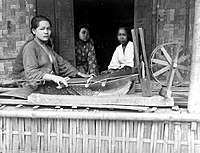
 Sarung denotes a length of fabric as a garment.
Sarung denotes a length of fabric as a garment.
Sarong or "sarung" denotes the lower garment worn by the Indonesian (and other Maritime Southeast Asian) men. This consists of length of fabric about a yard (0.91 m) wide and two-and-a-half yards (2.3 m) long. In the center of this sheet, across the narrower width, a panel of contrasting color or pattern about one foot wide is woven or dyed into the fabric, which is known as the kepala or "head" of the sarong. This sheet is stitched at the narrower edges to form a tube. One steps into this tube, brings the upper edge above the level of the navel (the hem should be level with the ankles), positions the kepala at the center of the back, and folds in the excess fabric from both sides to the front center, where they overlap and secures the sarong by rolling the upper hem down over itself. Malay men wear sarongs woven in a check pattern; women wear sarongs dyed in the batik method, with, for example, flower motifs, and in brighter colors. However, in Javanese culture, the wearing of batik sarung is not restricted to women on formal occasions such as weddings.
The sarong is common wear for women, in formal settings with a kebaya blouse. Malay men wear sarongs in public only when attending Friday prayers at the mosque, but sarongs remain very common casual wear at home for men of all ethnicities and religions in Brunei, Indonesia, Philippines, Malaysia, Singapore, Sri Lanka, and much of the Indian subcontinent.[2] (In the Indian subcontinent, excluding Sri Lanka, sarongs are sometimes known as mundu or lungi).
Regional variations
Arabian Peninsula
 Yemeni men in traditional sarongs.
Yemeni men in traditional sarongs.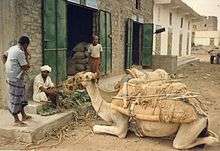 Yemeni man tying his futah (sarong). Sometimes people keep money and other small utensils in the folds of the futah.
Yemeni man tying his futah (sarong). Sometimes people keep money and other small utensils in the folds of the futah.
Sarongs known under a variety of local names are traditionally worn by the people of Yemen and elsewhere on the Arabian Peninsula. Local names for the garment include fūṭah, izaar, wizār and maʿwaz (pl. maʿāwiz). In Hadhramawt sarong is called ṣārūn in the interior and ṣārūm in the coastal region. In Oman, sarongs are called wizār and are often white in color, similar to the Keralan mundu of the Indian subcontinent and it is usually worn under the Thawb. In Saudi Arabia, sarongs are known as izaar. Designs can be checkered or striped as well floral or arabesque, but double plaid (i.e., a vertical section of the izār with a different plaid pattern) designs from Indonesia are also very popular. In southwestern Saudi Arabia, tribal groups have their own style of unstitched izaar, which is locally woven. This is also worn in northern Yemen. However, the tribal groups in Yemen each have their own design for their fūṭah, the latter of which may include tassels and fringes. It is thought that these tribal futah resemble the original izaar as worn on the Arabian Peninsula since pre-Islamic times such as the Shendyt. They are generally worn open and unstitched in such a way that the garment does not reach over one's ankles. Other izaars, often imported from Bangladesh, are the traditional clothing of Arab fishermen of the Persian Gulf, the Indian Ocean and the Red Sea. It was the traditional garment for men before the introduction of pant-like pajamas and kaftans during the Turkish and European colonial periods. Tube-stitched, as well as open sarongs, are both worn, even in formal dishdasha-wearing countries, as casual sleepwear and at home.
Indian subcontinent
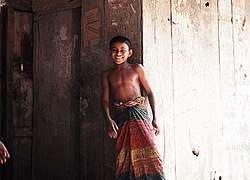 Bangladeshi boy in a traditional lungi.
Bangladeshi boy in a traditional lungi. Indian Bhangra dancers in lungi.
Indian Bhangra dancers in lungi.
Sarongs, very similar to those of South-East Asia and completely different from the Indian subcontinent (excluding Sri Lanka) are widespread – in the state of Manipur, where they are called Phanek and Mekhela in Assam which are very similar to traditional attires of other South-East Asian nations. In the South Indian states of Kerala, where they are called mundu (if fully white or fully black) and lungi or kaili if coloured, and Tamil Nadu, where they are called kaili or saaram or vetti or lungi and are usually worn at home. A standard lungi measures 2.12 by 1.2 metres.
Unlike the brightly colored Southeast Asian sarongs, the Kerala variety (the mundu) is more often plain white and is worn for ceremonial or religious purposes. In Kerala, the brightly coloured sarongs are called kaily and the white ones are called mundu. The more formal, all-white dhoti is worn for formal and religious occasions. While there are dresses based on the mundu which can be worn by women, they more commonly wear the sari.
Sri Lanka
Sarongs are very common in Sri Lanka and worn only by men. (A similar garment is worn by women. However, the women's garment is called "redda", which is wrap-around skirt.) It is the standard garment for most men in rural and even some urban communities. However, most men of upper social classes (whose public attire is trousers) wear the sarong only as a convenient night garment or only within the confines of the house. The Tamil-speaking communities, the Sri Lankan Tamils and the Sri Lankan Moors people also call it Saaram or Chaaram.
Statistically, the number of people wearing sarong as their primary public attire is on the decline in Sri Lanka; the reason being that the sarong carries the stigma of being the attire for less educated lower social classes. However, there is a trend toward adopting sarong as a fashionable garment or as a formal garment worn with national pride, only on special occasions.[3] Political and social leaders of Sri Lanka who want to portray their humility and closeness to "common man" and their nationalism, choose a variation of the sarong nicknamed the "national" as their public attire.
Horn of Africa
Sarongs are ubiquitous in Somalia and the Muslim-inhabited areas of the Horn of Africa. Although nomadic and urban Somali men have worn them for centuries in the form of a plain white skirt, the colorful macawiis (ma'awiis) sarong, which is the most popular form of the garment in the region, is a relatively recent arrival to Somalia courtesy of trade with the Southeast Asian islands and the Indian subcontinent. Before the 1940s, most macawiis were made of cotton. However, since the industrialization of the market for sarongs, they now come in many fabrics and combinations thereof, including polyester, nylon and silk.
Designs vary greatly and range from checkered square motifs with watermarked diamonds and plaid to simple geometric lines. The one constant is that they tend to be quite colorful; black macawiis are rare. Sarongs in Somalia are worn around the waist and folded several times over to secure their position. They are typically sold pre-sewn as one long circular stretch of cloth, though some vendors offer to sew them as a value-added service.
Southeast Asia
Philippines
 A Tagalog royal couple wearing tapis and baro from the Boxer Codex (c. 1590). The man's salawal is drawn up at the waist and tied.
A Tagalog royal couple wearing tapis and baro from the Boxer Codex (c. 1590). The man's salawal is drawn up at the waist and tied._(40246611432).jpg) T'nalak textiles from the T'boli people
T'nalak textiles from the T'boli people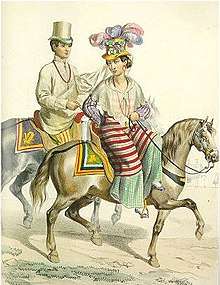
_from_the_Philippines%2C_Sulu_Archipelago%2C_Honolulu_Museum_of_Art_.jpg) A patadyong from the Sulu Archipelago in the Honolulu Museum of Art
A patadyong from the Sulu Archipelago in the Honolulu Museum of Art
Sarong from the Philippines are generally known as tapis in Luzon, patadyong in the islands of Visayas and Sulu, and malong in Mindanao. They are worn by both men and women and can be rectangular or tube-like. They can be knee-length or ankle-length and come in various colors that are usually unique to the specific ethnic group that wove them. Among men, the skirt is usually drawn up and tied at the waist, forming a trouser-like clothing known as a salawal. They can also serve as shawls or blankets. They were paired with close-fitting shirts or jackets known as baro or bayu.[4][5][6][7][8]
Among the Maranao people, the malong is featured in the folk dance kapa malong malong which shows the various ways that the malong can be utilized.[9]
During the Spanish colonial era, the tapis was worn over a longer Spanish skirt (saya or falda) due to the shortness of the tapis being deemed too immodest by the Spanish clergy to be worn alone. It evolved over time to become part of the traditional Filipino dress for women, the baro't saya.[6][10]
Western world
In North and South America as well as Europe, hip wraps are worn as beach wear or as a cover-up over swimwear. The wrap is often made of a thin, light fabric, often rayon, and may feature decorative fringing on both sides. They may have ties, which are long thin straps of fabric which the wearer can tie together to prevent the wrap from falling down. These wraps are mostly worn by women as beach cover ups and do not usually resemble traditional Asian or African sarongs in size, pattern or design. Western men who wear male sarongs are influenced by the Scottish kilt or lava-lava within the Polynesian or Samoan culture. Typically sarongs are worn by men when they are at home or at the beach or as a cover up on a nude beach or by the pool or on a cruise.[11]
Securing
Numerous tying methods exist to hold a sarong to the wearer's body. In some cases, these techniques customarily differ according to the sex of wearer. If a sarong has ties, they may be used to hold it in place. Sarong ties give the wearer a little extra hold and security.[12] If no ties exist, a pin may be used, the fabric may be tightly tucked under itself in layers, the corners of the main sheet may be around the body and knotted, or a belt may be used to hold the sarong in place.
Similar garments
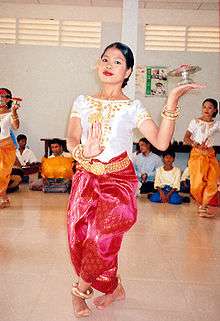
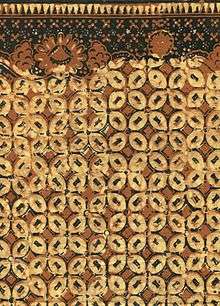
The basic garment known in English most often as a "sarong", sewn or unsewn, has analogs in many regions, where it shows variations in style and is known by different names.
- Africa
- In East Africa, it is called either a kanga (worn by African women), or a kikoy, traditionally worn by men and used with much simpler designs, however, it is used more frequently in high fashion. Kangas are brightly coloured lengths of cotton that incorporate elaborate and artistic designs and usually include the printing of a Swahili proverb along the hem.
- In Madagascar it is called a lamba.
- In Malawi it is called a chitenje.
- In Somalia it is called a Macawis
- In Mauritius they are called pareos.
- In Mozambique it is called a capulana.
- In South Africa it is called a kikoi and commonly used as a furniture throw or for going to the beach.
- In Zambia they are known as chitenge.
- Brazil
- "Kangas" or "cangas" are used in Brazil as swimwear by women. Those are readily available at beaches and littoral cities, but are also found in shops in the countryside for swimming in pools or rivers.
- Middle East
- In Saudi Arabia, it is called "Fouta" (Arabic: فوطه).
- In Yemen, it is called either "Fouta" (Arabic: فوطه) or "Meouaz" (Arabic: معوز).
- Indian subcontinent
- In South India it is called a lungi. It is most often sewn into a large cylindrical shape, so there is no slit when the phanek or lungi is tied.
- In eastern India and Bangladesh it is known as a lungi.
- In Northeastern India traditional clothing are the Phanek in Manipur and Mekhela in Assam which are very similar to the traditional attires of other South-East Asian nations and are completely different from the Indian subcontinent.
- In South India it is called Veetti in Tamil, pancha in Telugu, panche in Kannada, and Mundu in Malayalam.
- In the Maldives, and Indian state of Kerala, it is known as a mundu, feyli[13] or neriyathu.
- In Punjab it is a called Chadra.
- In Sri Lanka it is called Saram in Tamil, and Sarama in Sinhalese.
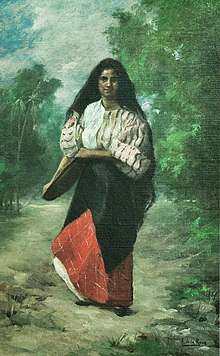
- In Cambodia it is used as an alternative to sampot.
- In Indonesia it is generally known as a kain sarung ('sarong cloth') except for in Bali where it carries the name 'Kamben'.
- In Laos and Isan (northwestern Thailand), it is called a Sinh (Lao: ສິ້ນ, Thai: ซิ่น), also sarong as well.
- In Malaysia it is known as a kain, kain pelikat, kain sarung,[15] kain tenun, kain batik, or kain sampin (specialised sarong worn by men with Baju Melayu). In Malaysian state of Sarawak, it is called sabok (for men) and tapeh (for women).
- In Myanmar, it is known as a longyi.
- In the Philippines it is generally known as malong (in Mindanao), patadyong (in Visayas and the Sulu Archipelago), and tapis (in Luzon). It can function as a skirt for both men and women, a turban, Niqab, Hijab, a dress, a blanket, a sunshade, a bedsheet, a "dressing room", a hammock, a prayer mat, and other purposes. During the Spanish colonial period, it evolved into a distinctive outer covering of the skirt for the baro't saya.[16]
- In Thailand, it is known as a pha khao ma (Thai: ผ้าขาวม้า) for men and a pha thung (Thai: ผ้าถุง) for women.

- Pacific Islands
- In Fiji it is known as a sulu.
- In Hawaii it is referred to as "kikepa."
- In Papua New Guinea the Tok Pisin term is lap-lap. Worn by men and women. In the other lingua franca, Hiri Motu, it is called "rami".
- In Rotuma, it is known as a "hạ' fạli"
- In Samoa it is known as a lavalava (also lava-lava).
- In Tahiti and Cook Islands it is known as a pāreu.
- In Tonga it is known as tupenu.
In the media
The American public is most familiar with the sarong for the dozens of films set in the South Seas, most of them romantic dramas made in the 1930s and 1940s. Dorothy Lamour is by far the actress most linked with the garment, which was designed by Edith Head. Lamour starred in multiple films of this genre, starting with The Hurricane in 1937. In fact, Lamour was nicknamed "The Sarong Girl" by the press and even wore a sarong on occasion in more traditional films. Among the other actresses to don the sarong for film roles are Maria Montez, Gilda Gray, Myrna Loy, Gene Tierney, Frances Farmer and Movita. Male stars who wore the manly sarongs on film include Jon Hall, Ray Milland, Tyrone Power, Robert Preston, Sabu Dastagir and Ralph Fiennes in The Constant Gardener. The sarong was also worn by Pierce Brosnan in The Thomas Crown Affair (1999). The 2005 documentary film Soldiers in Sarong, directed by Lokendra Arambam, depicts the women's resistance movement in Manipur, North-East India.[17] In Singapore, the term Sarong Party Girl refers to a local single Singaporean woman especially of Chinese ethnicity who favour socializing and having relationships with expatriate Caucasian men rather than the local ones.
See also
| Wikimedia Commons has media related to sarongs. |
| Look up sarong in Wiktionary, the free dictionary. |
Notes
- "Selyn - Fair Trade Handlooms". Selyn - Fair Trade Handlooms. Retrieved 28 March 2018.
- "Singh, Atom Sunil; "Indigenous Games between Cambodia and Manipur: A Borderless Connectivity"". E-pao.net. Retrieved 2011-09-18.
- http://www.travelsrilanka.com/index.cfm?PAGE=1176 Archived October 7, 2007, at the Wayback Machine
- So, Michelle. Caught in the Net: ‘Tapis’ cops(editorial column) Sun Star Cebu. April 17, 2008 Archived April 20, 2008, at the Wayback Machine
- "The Filipiniana Dress: The Rebirth of the Terno". Vinta Gallery. Retrieved 19 February 2020.
- Coo, Stéphanie Marie R. (2014). Clothing and the colonial culture of appearances in nineteenth century Spanish Philippines (1820-1896) (PhD). Université Nice Sophia Antipolis.
- Perdon, Renato (22 August 2013). "Muslim Filipinos: An Ethnic Ensemble". Munting Nayon. Retrieved 20 February 2020.
- Lorna Kaino (1995). The Necessity of Craft: Development and Women's Craft Practices in the Asian-Pacific Region. University of Western Australia Press. p. 52. ISBN 978-1-875560-62-2.
- "Kapa Malong-Malong". DanceAndDance. Retrieved 14 July 2020.
- Scott, William Henry (1994). Barangay: Sixteenth Century Philippine Culture and Society. Quezon City: Ateneo de Manila University Press. ISBN 971-550-135-4.
- "The Sarong Source". 1 World Sarongs Blog. www.1worldsarongs.com. 2014-04-03. Retrieved 2016-09-21.
- "1 World Sarongs".
- Sarong, The British Museum
- "Baro't Saya". Philippine Folklife Museum Foundation. Retrieved 19 February 2020.
- Mohamad, Maznah (28 March 1996). "The Malay Handloom Weavers: A Study of the Rise and Decline of Traditional Manufacture". Institute of Southeast Asian Studies. Retrieved 28 March 2018 – via Google Books.
- "Tapis". Philippine Folklife Museum Foundation. Retrieved 19 February 2020.
- "Soldiers in Sarong directed by Lokendra Arambam". Cultureunplugged.com. Retrieved 2011-09-18.